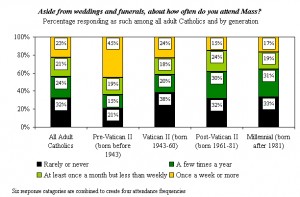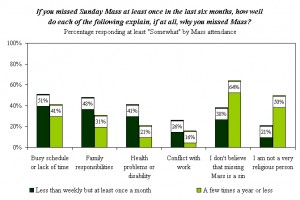
There are different ways of assessing the relative health or distress of the Catholic Church here in America. In yesterday’s blog we discussed some signs of vitality, in terms of both clergy and laity becoming more focused on the urgency of evangelization, and of personal conversion. There are many other ways of noting our strengths and struggles.
One of the most obvious metrics is to look at the raw numbers and ask, “Is the Catholic Church in America growing or shrinking?” A recent article at the blog of the Center for Applied Research in the Apostolate (CARA) addresses this question, and I would like to present a quick summary of some of the findings. But at the end of the day I am also left with a fundamental question.
First a quick summary of the article. (The Full Article is HERE)
The article appears on the CARA blog “1964,” and is authored by Mark Gray, the usual researcher and blogger at the site. He is critiquing a study released recently by the Public Religion Research Institute (PRRI), which seeks to make a case for “disappearing Catholics” in American culture. Mark Gray of CARA unambiguously states that the PRRI study is just plain wrong, and emphasizes that the Catholic share of the US population has remained relatively stable at about 25% (+ or – 3) of the US population. He further argues that, while some hold that we are retaining this percentage only due to immigration, the overall effect of immigration is far less than most people assume.
The usual narrative, or “conventional wisdom” is that the Catholic Church has been hemorrhaging numbers and that massive amounts of people are leaving the Church, which is only being saved by the arrival of large numbers of Hispanic immigrants.
But this “conventional wisdom” is largely set aside by the fact that foreign-born Catholics make up only 24% of the US Catholic population. Immigration from the south has also leveled off a great deal since 2007. Thus while immigration has contributed to the stability of the Catholic population percentage, it is not nearly the to the degree argued by many.
Another largely overlooked factor in the stability of Catholic numbers, is the phenomenon known as “reverts.” The fact is, there is a lot of “coming and going” in the Church. And while much is made of those who go forth from the Church, (ca 12% of cradle Catholics leave), the fact is, many will go eventually come back. Currently there are some 5 million Catholics who describe themselves as “reverts,” i.e. those who have returned after a significant absence.
The number of new converts is also not insignificant.
Gray therefore speaks of a kind of “life-cycle” that makes up the overall Catholic total of 25% of the US population (See diagram above from CARA). In this life-cycle, some go out of the Church, leaving her never to return. Others leave, but doing in fact return to the Church later in life. And to the number of returning Catholics is added the numbers of immigrants entering the U.S. Church, and those who convert to the Church later in life from other denominations, or from unbelief.
This is a complex life-cycle which is not easily captured by many snapshot polls that observe only a moment in time. And while polls that depict the numbers of those who leave often make the news, the more complex numbers stretched out over the life-cycle of Catholic demographics, do not make the news and are not easily reduced to headlines.
This leads Mark great to comment on why he thinks some numbers make the news, and other don’t:
So if life-cycle effects are so important to explaining how the US Catholic population percentage remains stable, and how the US Catholic population continues to grow, why isn’t this part of the conventional wisdom? In part, because I don’t think there are many people who want to hear it. Most religion reporters ignore research that indicates growth in, or satisfaction with the Catholic Church (while they go mega–front page crazy over stories that mention religious decline)… Even within the Church many don’t want to hear it. Both “progressive” and “traditional” Catholics want to be able to argue that the Church is losing members and can only regain them by urgently doing _________. Many would like to continue believing the Church is hemorrhaging members, and that Mass attendance is declining, even though neither of these claims can be found in the data. [2]
Gray has written elsewhere that Mass attendance has remained relatively stable at 25% of Catholics for over a decade now. And you can see that HERE.
OK, so, according to Mark Gray and the data he presents, it’s steady as you go for the Church in the past two decades both in terms of our percentage of the U.S. population and Mass attendance. I have great respect both for CARA and Mark Gray, and have read their material over the years. I find a deep respect for the data at CARA and a distinct hesitation by them to spin the data for some cause. This is good scholarship and I respect it.
But I do wonder how to square the data with my own experience as a priest. Of course my experience is only anecdotal, but it does join with the experience of many other priests and lay people I know. And my felt experience is that the Church is shrinking in many ways. As a youngster and even into college years I remember standing room only at most parishes for the principal liturgies. I remember full schools with waiting lists, and a kind of building boom as the Church claimed the suburbs. Now most parishes look to be significantly eroded here in the DC area. We have closed many schools and some parishes are not far from closure as well. According to our October “headcount” data, the number attending Mass in the past 12 years has dropped every year about 1% such that we have lost about 25,000 Catholics attending Mass overall in the DC area, though the population of DC has overall increased by about 13% in the past decade. Sacramental data, especially weddings have also declined over the last decades.
Now, of course Washington DC and its suburbs is a small sliver of data compared to the overall national numbers in the Church. Further, one might reasonably expect that the forces of secularization would be stronger in what is both a large urban area, and which trends liberal. And yet, many other dioceses have taken to closing schools and parishes throughout the country and this too adds to the impression of a loss scenario, not a steady as you go scenario. But again, as Mark Gray points out, the bad news gets the headlines.
So what are we to make of the national data and our local experience? Again, I trust CARA and Mark Gray is a straight shooter. But I am interested in your thoughts and even more your experience and actual data.
I am struck by his observation that many “want” the Church to be losing members for any number of reasons and agendas. So before you or I simply say what we think, it might be good to check a few of our premises that might color how we see things.
I personally experience a little disconnect with the analysis that Church numbers are steady, especially when it comes to Mass attendance and sacraments. But my sample is small: me and a few close friends and relatives.
How say you? What is your experience? Is the Church in your area growing, shrinking or holding steady?
This video is from 2009


